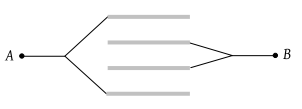If there are n capacitors each of capacitance C in parallel connected to V volt source, then the energy stored is equal to
1. CV
2.
3. CV2
4.
The unit of electric permittivity is
1. Volt/m2
2. Joule/coulomb
3. Farad/m
4. Henry/m
(i) The energy stored in the capacitor when the battery is disconnected and the separation is doubled is \(E_1\)
(ii) The energy stored in the capacitor when the charging battery is kept connected and the separation between the capacitor plates is doubled is \(E_2\).
Then \(\frac{E_1}{E_2}\) value is:
1. \(4\)
2. \(\frac{3}{2}\)
3. \(2\)
4. \(\frac{1}{2}\)
Two identical capacitors are joined in parallel, charged to a potential V and then separated and then connected in series i.e. the positive plate of one is connected to negative of the other
1. The charges on the free plates are destroyed
2. The charges on the free plates are enhanced
3. The energy stored in the system increases
4. The potential difference in the free plates becomes 2V
A parallel plate capacitor is made by stacking n equally spaced plates connected alternately. If the capacitance between any two plates is C then the resultant capacitance is
1. C
2. nC
3. (n – 1)C
4. (n + 1)C
Four plates of equal area A are separated by equal distances d and are arranged as shown in the figure. The equivalent capacity is
1.
2.
3.
4.
A parallel plate capacitor with air as medium between the plates has a capacitance of 10 μF. The area of capacitor is divided into two equal halves and filled with two media as shown in the figure having dielectric constant k1 = 2 and k2 = 4. The capacitance of the system will now be
1. 10 μF
2. 20 μF
3. 30 μF
4. 40 μF
Three capacitors are connected to D.C. source of 100 volts shown in the adjoining figure. If the charge accumulated on plates of C1, C2 and C3 are and qf respectively, then
1.
2.
3.
4.
n identical condensers are joined in parallel and are charged to potential V. Now they are separated and joined in series. Then the total energy and potential difference of the combination will be
1. Energy and potential difference remain the same
2. Energy remains the same and the potential difference is nV
3. Energy increases n times and potential difference is nV
4. Energy increases n times and potential difference remains the same
Five capacitors of 10 μF capacity each are connected to a d.c. potential of 100 volts as shown in the adjoining figure. The equivalent capacitance between the points A and B will be equal to
1. 40 μF
2. 20 μF
3. 30 μF
4. 10 μF










